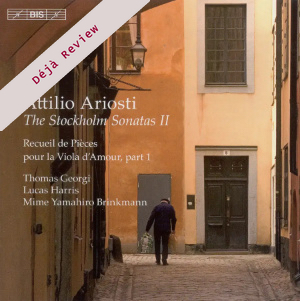
Déjà Review: this review was first published in August 2007 and the recording is still available.
Attilio Ariosti (1666-1729)
The Stockholm Sonatas II
Sonata No.8 in D Minor
Sonata No.9 in G Minor
Sonata No.10 in F Major
Sonata No.11 in A Minor
Sonata No.12 in E Minor
Sonata No.13 in C Major
Sonata No.14 in E flat Major
Thomas Georgi (viola d’amore), Lucas Harris (archlute; baroque guitar), Mime Yamahiro Brinkmann (cello)
rec. 2006, Länna Church, Sweden
BIS BISCD1555 [57]
This CD is the continuation of viola d’amore specialist Thomas Georgi’s The Stockholm Sonatas I (BIS-CD-1535), resurrecting the neglected music of Attilio Ariosti. The first volume consisted of the music published by Ariosti in London as a set of ‘Lessons for the Viola d’Amour’. The works were preserved in Stockholm in a manuscript entitled ‘Receuil de Pièces’ and copied by the Swedish composer Johan Helmich Roman in the late 1710s during his studies in London. Based on the Stockholm manuscript, Georgi has made his own edition of the works. This recording comprises the first 7 of the 15 ‘sonatas’ contained in the Receuil, leaving the remainder for a final, third volume in the series.
Highly regarded by his contemporaries as a singer, organist, cellist and dramatist, Ariosti has been more or less forgotten for more than two centuries. In his liner notes Georgi underlines Ariosti’s “remarkable twists of harmony, his witty way with silence as well as with notes, his preference for juxtaposition of contrasting material over development of a single idea”; wondering if these qualities would have found him “as wide an audience as Corelli’s”, had the viola d’amore remained popular as an instrument. As on the first disc, Georgi is joined by lutenist Lucas Harris, and this time by different cellist, Mime Yamahiro Brinkmann, another product of that excellent Early Music Department at my place of work, the Royal Conservatoire in The Hague.
Thomas Georgi has used the title ‘Sonata’ for these works even though the word is never used in the manuscript source. “They sound like sonatas to me” is his almost belligerent declaration, and I admire his pioneering spirit in cutting through a potential quagmire of nomenclatural red tape. His expertise and scholarly research mean that his treatment of embellishments in this music is based on the historical examples of contemporary performers. Citing Corelli as a model, the scores are taken as a framework from which a player of the time would have used partially as a springboard on which their own technical and expressive abilities would have had a significant effect with regard to the final result. In his review of the fist disc of this series, Gary Higginson describes these works as ‘second-rate music’ – in which I would agree that they don’t really plumb great emotional depths to our modern ears. For the purpose that they were no doubt intended they are however ‘first-rate’, as your gigging reviewer can confirm. A composer writing to satisfy players and a mixed audience walks a narrow line between being over-demanding and dull. Ariosti is neither of these things, providing plenty of interesting music for all of the musicians involved, enough wow factor and variety to keep the elderly aunts and uncles awake in the front row, and keeping enough in reserve not to annoy the wealthy patrons at the back who are having a boozy chat through the whole thing. The handkerchief waving bewigged gentry of the time swooned hopelessly at anything too dissonant in any case, so Ariosti knew exactly what he was doing with these works.
Thomas Georgi’s Viola d’amore has an ‘alto’ pitch range, but while the general tessitura is lower than a violin, the colour is in fact quite bright. The strings have a thicker, more throaty texture in tone, but the overall effect is highly attractive, and the balance between violoncello and lute, the glue which links the two, is nicely struck. I note that these have been recorded in a different acoustic to volume one, but Bis’s reliably wonderful recording techniques have created another winning balance between close detail and spaciousness. It may well be that the CDs from this series end up being used as background music to chic dinners, but now all those embarrassing pauses can be filled with at least one sensible question: “…mmm, I like this music, what is it?”
Dominy Clements
If you purchase this recording using a link below, it generates revenue for MWI and helps us maintain free access to the site



















